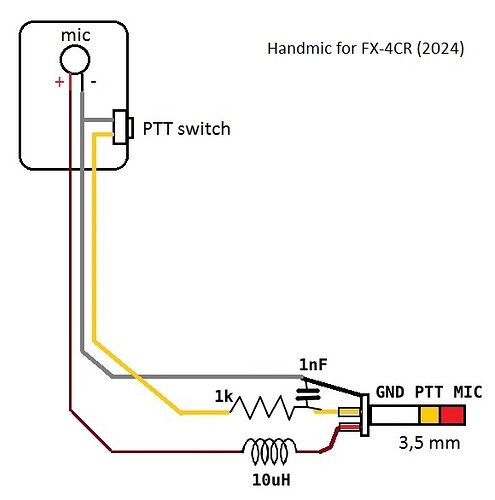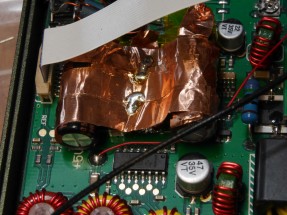Hello,
Here an update of my review on this rig.
I have been using my FX-4CR (third version), bought in november 2024, and I must say it’s working pretty well.
Using the rig is easy and the most useful features (CW speed, power, tuning…) are accessible with the controls without requiring going into menus.
As explained before, CW mode was working just perfect, but when in SSB I had a few coments of bad or extrange audio when in higher bands (21 - 28 MHz).
It seems the rig is somewhat sensitive to RF feedback when using End Fed Half wave antennas and you are close to the antenna in the field.
To solve the issue I did two actions:
- I prepared a 2 meter long RG-174 coaxial and added a choke (14 turns on a FT 114-43 ferrite) near the feed point of the EFHW transformer.
- I exchanged email with Simon ZL1THH who suggested modifying my hombrew small microphone to prevent from RF ingress via the mic cable. This is what I have now:
I tested on my last activation (2-Jan-2024) both in 28 and 14 MHz, and I asked several times to my chasers a feedback of my voice. They all replied my voice sounded right and nothing extrange.
It seems everything will be fine from now on concerning RF feedback.
Are there high power peaks on SSB transmission?
When I used the rig I observed that while I had settled my power lower than 10 watt, the display was showing some peaks of power higher than 10 watt at times, as I talked on the mic.
I verified I had correct settings on the rig, not producing the trouble due to an incorrect excessive gain. This is what I had in the menus:
- firmware version: 1.7
- mic gain: 10 (max 99)
- TX Filter: 5 (0 to 5). 5 means 3 kHz bandwidth.
- TX AF-Compress: 15 (1 to 99)
The instruction manual says that Mic gain should be not further than 10 to avoid distortion.
Okay, so the settings seem correct but, why are there these peaks?
At home I put a dummy load and to my surprise there were high peaks as well, so this is not related to the antenna in the field, but should be something in the programming of the rig for SSB.
I recorded a video that shows the difference between CW (acqurate power) and SSB (peaks at times), having settled the power to 10 watt. Pay attention to the display and measuring needle in the external meter:
As you see, by looking at the rig display and at the power measuring needle, the behaviour is very different:
-
CW: a key down produces a straight impulse so that the needle reaches the settled power straight on, while
-
SSB: the red bar on the rig`s display shows at times that the power is higher than settled (> 10 w).
Is that difference dangerous for the rig on SSB? The needle shows a very short jump coincident to the higher readings on the display, nevertheless, the power is not really going as high as for CW, so I suspect that the SSB peaks last a very short time, and probably not noticeable on air, maybe?
I had played the video very slowly and I see the peaks are produced here and there depending on the letter I spell, but they last miliseconds.
What do you think?
I’ll report YU, BG2FX, about this subject to see if there is any bug in the current firmware v.1.7
73 Ignacio














